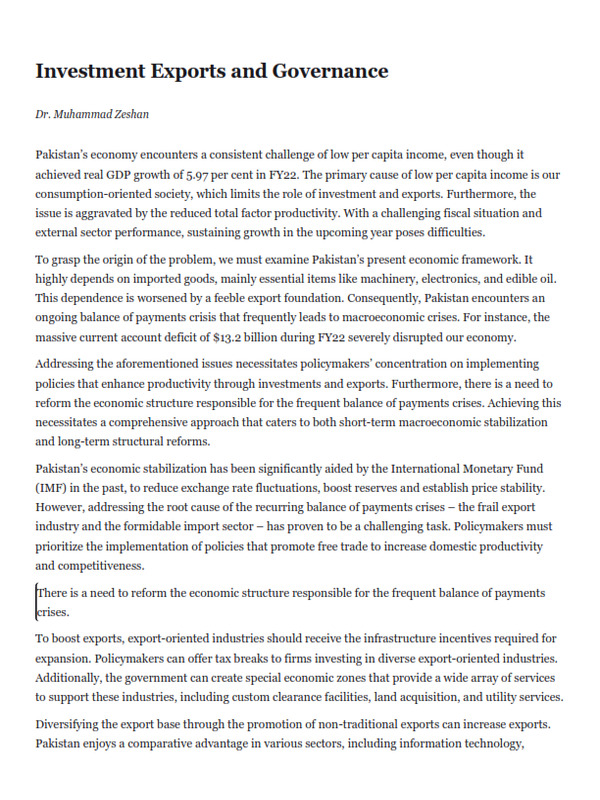Investment Exports and Governance
Pakistan’s economy encounters a consistent challenge of low per capita income, even though it achieved real GDP growth of 5.97 per cent in FY22. The primary cause of low per capita income is our consumption-oriented society, which limits the role of investment and exports. Furthermore, the issue is aggravated by the reduced total factor productivity. With a challenging fiscal situation and external sector performance, sustaining growth in the upcoming year poses difficulties.
To grasp the origin of the problem, we must examine Pakistan’s present economic framework. It highly depends on imported goods, mainly essential items like machinery, electronics, and edible oil. This dependence is worsened by a feeble export foundation. Consequently, Pakistan encounters an ongoing balance of payments crisis that frequently leads to macroeconomic crises. For instance, the massive current account deficit of $13.2 billion during FY22 severely disrupted our economy.
Addressing the aforementioned issues necessitates policymakers’ concentration on implementing policies that enhance productivity through investments and exports. Furthermore, there is a need to reform the economic structure responsible for the frequent balance of payments crises. Achieving this necessitates a comprehensive approach that caters to both short-term macroeconomic stabilization and long-term structural reforms.
Pakistan’s economic stabilization has been significantly aided by the International Monetary Fund (IMF) in the past, to reduce exchange rate fluctuations, boost reserves and establish price stability. However, addressing the root cause of the recurring balance of payments crises – the frail export industry and the formidable import sector – has proven to be a challenging task. Policymakers must prioritize the implementation of policies that promote free trade to increase domestic productivity and competitiveness.
There is a need to reform the economic structure responsible for the frequent balance of payments crises.
To boost exports, export-oriented industries should receive the infrastructure incentives required for expansion. Policymakers can offer tax breaks to firms investing in diverse export-oriented industries. Additionally, the government can create special economic zones that provide a wide array of services to support these industries, including custom clearance facilities, land acquisition, and utility services.
Diversifying the export base through the promotion of non-traditional exports can increase exports. Pakistan enjoys a comparative advantage in various sectors, including information technology, pharmaceuticals, and agribusiness. However, these sectors have not been fully exploited yet. To promote investment in these sectors, the government could provide tax breaks and facilitate research and development.
Further, the government should eliminate import tariffs and other trade barriers in the long run, which create economic distortions. It will provide high-tech capital goods to industry essential for sustained productivity.
Apart from the short-term measures, policymakers should also concentrate on long-term structural reforms. This necessitates tackling the root causes that have led to low productivity growth in Pakistan. Inadequate investment in physical and human capital is one of the primary reasons behind this. To resolve this, we should prioritize augmenting investments in infrastructure, education, and healthcare. Investing in infrastructure can enhance productivity and streamline operations for export-oriented industries. For example, investing in transportation infrastructure like highways and railways can boost logistics efficiency and lower export costs. Additionally, investing in education and healthcare can enhance human capital, which is vital for fostering productivity growth.
One more problem that requires attention is the feeble institutional framework. Weak institutions, comprising the legal system, property rights, and regulatory environment, have impeded economic growth by generating an uncertain business atmosphere. To tackle this issue, we must prioritize strengthening institutions by enhancing the legal system from scratch, securing property rights, and constructing a favourable regulatory environment for businesses to function.
In addition, Pakistan’s labour market is marked by a significant informal sector, restricted employment prospects, and inadequate wages. To tackle these challenges, policymakers must prioritize labour market reforms aimed at establishing a more comprehensive and participatory labour market. This may involve minimizing labour market inflexibilities, such as the minimum wage, which could impede job opportunities, and implementing policies that promote the establishment of labour unions and collective bargaining.
Apart from the structural reforms, Pakistan requires attention to governance issues. Inadequate accountability and political instability have resulted in a difficult business environment that discourages private investment. To tackle these problems, we need to prioritize enhancing governance by reinforcing institutions and promoting transparency and accountability. Implementing reforms also requires political will and a long-term perspective. Policymakers must acknowledge the significance of reforms and execute them promptly and effectively.
In addition, to successfully implement the reforms, a stable macroeconomic environment should provide support. Although IMF programs have aided in stabilizing Pakistan’s economy previously, the nation must decrease its dependency on external funding and augment its domestic revenue sources. This can be accomplished by broadening the tax base and curbing tax evasion.
To optimize resources for development, the government must limit expenses on non-development items. Downsizing government and bureaucracy, which currently use a significant portion of the budget, is one way to achieve this. It would allow funds to be redirected towards supporting an enabling environment for businesses, startups, and human capital investments.
Concluding, economic growth in Pakistan confronts challenges from recurring macroeconomic crises. For sustained economic growth, policymakers might consider policies that increase investment to improve productivity and exports and reform the economic structure that results in a frequent balance of payments crises. This demands a comprehensive approach that addresses short-term macroeconomic stabilization and long-term structural reforms. Although critical for sustained economic growth, these reforms require political will and a long-term perspective.
The writer is Research Fellow (Pakistan Institute of Development Economics)




